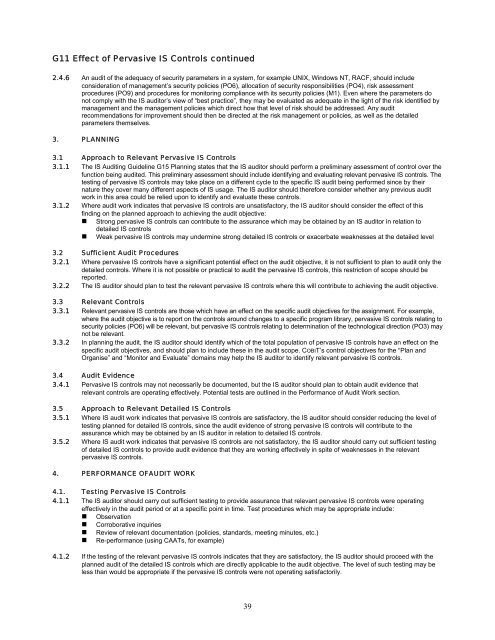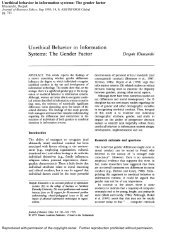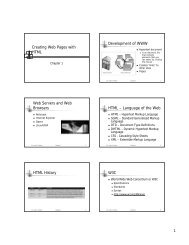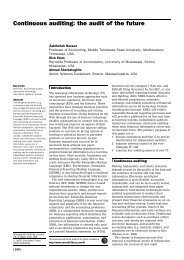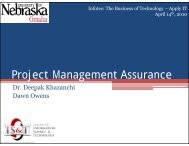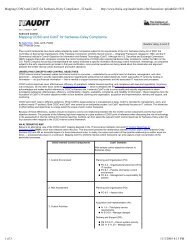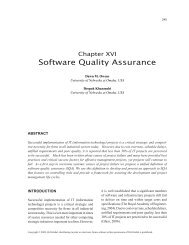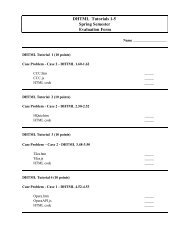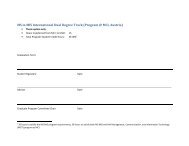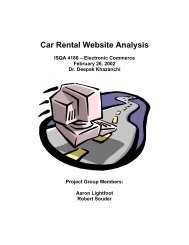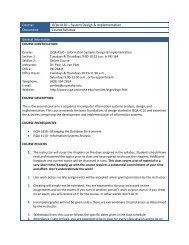IS Standards, Guidelines and Procedures for Auditing and Control ...
IS Standards, Guidelines and Procedures for Auditing and Control ...
IS Standards, Guidelines and Procedures for Auditing and Control ...
Create successful ePaper yourself
Turn your PDF publications into a flip-book with our unique Google optimized e-Paper software.
G11 Effect of Pervasive <strong>IS</strong> <strong>Control</strong>s continued2.4.6 An audit of the adequacy of security parameters in a system, <strong>for</strong> example UNIX, Windows NT, RACF, should includeconsideration of management’s security policies (PO6), allocation of security responsibilities (PO4), risk assessmentprocedures (PO9) <strong>and</strong> procedures <strong>for</strong> monitoring compliance with its security policies (M1). Even where the parameters donot comply with the <strong>IS</strong> auditor’s view of “best practice”, they may be evaluated as adequate in the light of the risk identified bymanagement <strong>and</strong> the management policies which direct how that level of risk should be addressed. Any auditrecommendations <strong>for</strong> improvement should then be directed at the risk management or policies, as well as the detailedparameters themselves.3. PLANNING3.1 Approach to Relevant Pervasive <strong>IS</strong> <strong>Control</strong>s3.1.1 The <strong>IS</strong> <strong>Auditing</strong> Guideline G15 Planning states that the <strong>IS</strong> auditor should per<strong>for</strong>m a preliminary assessment of control over thefunction being audited. This preliminary assessment should include identifying <strong>and</strong> evaluating relevant pervasive <strong>IS</strong> controls. Thetesting of pervasive <strong>IS</strong> controls may take place on a different cycle to the specific <strong>IS</strong> audit being per<strong>for</strong>med since by theirnature they cover many different aspects of <strong>IS</strong> usage. The <strong>IS</strong> auditor should there<strong>for</strong>e consider whether any previous auditwork in this area could be relied upon to identify <strong>and</strong> evaluate these controls.3.1.2 Where audit work indicates that pervasive <strong>IS</strong> controls are unsatisfactory, the <strong>IS</strong> auditor should consider the effect of thisfinding on the planned approach to achieving the audit objective:• Strong pervasive <strong>IS</strong> controls can contribute to the assurance which may be obtained by an <strong>IS</strong> auditor in relation todetailed <strong>IS</strong> controls• Weak pervasive <strong>IS</strong> controls may undermine strong detailed <strong>IS</strong> controls or exacerbate weaknesses at the detailed level3.2 Sufficient Audit <strong>Procedures</strong>3.2.1 Where pervasive <strong>IS</strong> controls have a significant potential effect on the audit objective, it is not sufficient to plan to audit only thedetailed controls. Where it is not possible or practical to audit the pervasive <strong>IS</strong> controls, this restriction of scope should bereported.3.2.2 The <strong>IS</strong> auditor should plan to test the relevant pervasive <strong>IS</strong> controls where this will contribute to achieving the audit objective.3.3 Relevant <strong>Control</strong>s3.3.1 Relevant pervasive <strong>IS</strong> controls are those which have an effect on the specific audit objectives <strong>for</strong> the assignment. For example,where the audit objective is to report on the controls around changes to a specific program library, pervasive <strong>IS</strong> controls relating tosecurity policies (PO6) will be relevant, but pervasive <strong>IS</strong> controls relating to determination of the technological direction (PO3) maynot be relevant.3.3.2 In planning the audit, the <strong>IS</strong> auditor should identify which of the total population of pervasive <strong>IS</strong> controls have an effect on thespecific audit objectives, <strong>and</strong> should plan to include these in the audit scope. COBIT’s control objectives <strong>for</strong> the “Plan <strong>and</strong>Organise” <strong>and</strong> “Monitor <strong>and</strong> Evaluate” domains may help the <strong>IS</strong> auditor to identify relevant pervasive <strong>IS</strong> controls.3.4 Audit Evidence3.4.1 Pervasive <strong>IS</strong> controls may not necessarily be documented, but the <strong>IS</strong> auditor should plan to obtain audit evidence thatrelevant controls are operating effectively. Potential tests are outlined in the Per<strong>for</strong>mance of Audit Work section.3.5 Approach to Relevant Detailed <strong>IS</strong> <strong>Control</strong>s3.5.1 Where <strong>IS</strong> audit work indicates that pervasive <strong>IS</strong> controls are satisfactory, the <strong>IS</strong> auditor should consider reducing the level oftesting planned <strong>for</strong> detailed <strong>IS</strong> controls, since the audit evidence of strong pervasive <strong>IS</strong> controls will contribute to theassurance which may be obtained by an <strong>IS</strong> auditor in relation to detailed <strong>IS</strong> controls.3.5.2 Where <strong>IS</strong> audit work indicates that pervasive <strong>IS</strong> controls are not satisfactory, the <strong>IS</strong> auditor should carry out sufficient testingof detailed <strong>IS</strong> controls to provide audit evidence that they are working effectively in spite of weaknesses in the relevantpervasive <strong>IS</strong> controls.4. PERFORMANCE OFAUDIT WORK4.1. Testing Pervasive <strong>IS</strong> <strong>Control</strong>s4.1.1 The <strong>IS</strong> auditor should carry out sufficient testing to provide assurance that relevant pervasive <strong>IS</strong> controls were operatingeffectively in the audit period or at a specific point in time. Test procedures which may be appropriate include:• Observation• Corroborative inquiries• Review of relevant documentation (policies, st<strong>and</strong>ards, meeting minutes, etc.)• Re-per<strong>for</strong>mance (using CAATs, <strong>for</strong> example)4.1.2 If the testing of the relevant pervasive <strong>IS</strong> controls indicates that they are satisfactory, the <strong>IS</strong> auditor should proceed with theplanned audit of the detailed <strong>IS</strong> controls which are directly applicable to the audit objective. The level of such testing may beless than would be appropriate if the pervasive <strong>IS</strong> controls were not operating satisfactorily.39


